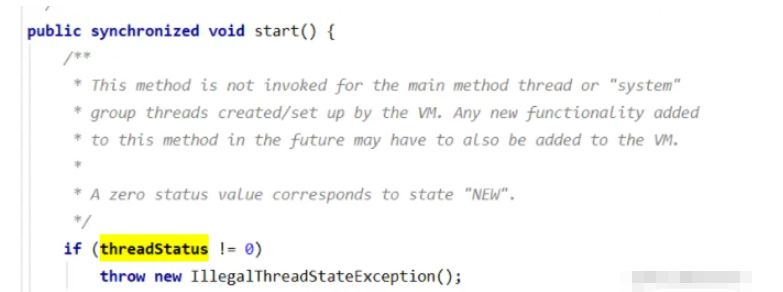жӮЁеҘҪпјҢзҷ»еҪ•еҗҺжүҚиғҪдёӢи®ўеҚ•е“ҰпјҒ
жӮЁеҘҪпјҢзҷ»еҪ•еҗҺжүҚиғҪдёӢи®ўеҚ•е“ҰпјҒ
иҝҷзҜҮвҖңJavaдёӯзәҝзЁӢжұ иҮӘе®ҡд№үеҰӮдҪ•е®һзҺ°вҖқж–Үз« зҡ„зҹҘиҜҶзӮ№еӨ§йғЁеҲҶдәәйғҪдёҚеӨӘзҗҶи§ЈпјҢжүҖд»Ҙе°Ҹзј–з»ҷеӨ§е®¶жҖ»з»“дәҶд»ҘдёӢеҶ…е®№пјҢеҶ…е®№иҜҰз»ҶпјҢжӯҘйӘӨжё…жҷ°пјҢе…·жңүдёҖе®ҡзҡ„еҖҹйүҙд»·еҖјпјҢеёҢжңӣеӨ§е®¶йҳ…иҜ»е®ҢиҝҷзҜҮж–Үз« иғҪжңүжүҖ收иҺ·пјҢдёӢйқўжҲ‘们дёҖиө·жқҘзңӢзңӢиҝҷзҜҮвҖңJavaдёӯзәҝзЁӢжұ иҮӘе®ҡд№үеҰӮдҪ•е®һзҺ°вҖқж–Үз« еҗ§гҖӮ
д»Һжәҗз ҒеҸҜд»Ҙеҫ—зҹҘпјҢи°ғз”Ёstartж–№жі•ж—¶пјҢзЁӢеәҸиҝҳдјҡеҲӨж–ӯеҪ“еүҚзҡ„зәҝзЁӢзҠ¶жҖҒ

иҝҷйҮҢеҸҲеј•з”іеҮәеҸҰдёҖдёӘй—®йўҳпјҢзәҝзЁӢеҲ°еә•жңүеҮ з§ҚзҠ¶жҖҒ
е№ҙиҪ»зҡ„ж—¶еҖҷиғҢе…«иӮЎж–Үж—¶пјҢеҸӘжҳҜиҜҙдә”з§ҚзҠ¶жҖҒпјҢиҝҷдә”з§ҚзҠ¶жҖҒд№ҹдёҚзҹҘйҒ“жҳҜе“ӘйҮҢжқҘзҡ„пјҢдёҚзҹҘйҒ“жңүжІЎжңүдәәе’ҢжҲ‘дёҖж ·пјҢеҪ“еҲқеҸӘжҳҜзҹҘ其然дёҚзҹҘе…¶жүҖд»Ҙ然гҖӮиҙҙеҮәжәҗз ҒжқҘпјҡ
public enum State {
/**
* Thread state for a thread which has not yet started.
*/
NEW, // ж–°е»ә
/**
* Thread state for a runnable thread. A thread in the runnable
* state is executing in the Java virtual machine but it may
* be waiting for other resources from the operating system
* such as processor.
*/
RUNNABLE, // иҝҗиЎҢдёӯ
/**
* Thread state for a thread blocked waiting for a monitor lock.
* A thread in the blocked state is waiting for a monitor lock
* to enter a synchronized block/method or
* reenter a synchronized block/method after calling
* {@link Object#wait() Object.wait}.
*/
BLOCKED, // йҳ»еЎһ
/**
* Thread state for a waiting thread.
* A thread is in the waiting state due to calling one of the
* following methods:
* <ul>
* <li>{@link Object#wait() Object.wait} with no timeout</li>
* <li>{@link #join() Thread.join} with no timeout</li>
* <li>{@link LockSupport#park() LockSupport.park}</li>
* </ul>
*
* <p>A thread in the waiting state is waiting for another thread to
* perform a particular action.
*
* For example, a thread that has called <tt>Object.wait()</tt>
* on an object is waiting for another thread to call
* <tt>Object.notify()</tt> or <tt>Object.notifyAll()</tt> on
* that object. A thread that has called <tt>Thread.join()</tt>
* is waiting for a specified thread to terminate.
*/
WAITING, // зӯүеҫ…
/**
* Thread state for a waiting thread with a specified waiting time.
* A thread is in the timed waiting state due to calling one of
* the following methods with a specified positive waiting time:
* <ul>
* <li>{@link #sleep Thread.sleep}</li>
* <li>{@link Object#wait(long) Object.wait} with timeout</li>
* <li>{@link #join(long) Thread.join} with timeout</li>
* <li>{@link LockSupport#parkNanos LockSupport.parkNanos}</li>
* <li>{@link LockSupport#parkUntil LockSupport.parkUntil}</li>
* </ul>
*/
TIMED_WAITING, // е®ҡж—¶зӯүеҫ…
/**
* Thread state for a terminated thread.
* The thread has completed execution.
*/
TERMINATED; // з»“жқҹзҠ¶жҖҒ
}з»јдёҠпјҢе…¶е®һзәҝзЁӢзҡ„зҠ¶жҖҒжңүе…ӯз§Қпјҡ
NEW ж–°е»әзҠ¶жҖҒпјҢдёҖиҲ¬йҖҡиҝҮThread thread = new Thread(runable);жӯӨж—¶зҡ„зәҝзЁӢеұһдәҺж–°е»әзҠ¶жҖҒгҖӮ
RUNABLE еҸҜиҝҗиЎҢзҠ¶жҖҒпјҢеҪ“и°ғз”Ёstartж—¶пјҢзәҝзЁӢиҝӣе…ҘRUNNABLEзҠ¶жҖҒ,иҜҘзҠ¶жҖҒе…¶е®һиҝҳеҢ…еҗ«дёӨдёӘзҠ¶жҖҒпјҢдёҖз§ҚжҳҜиў«cpuйҖүдёӯжӯЈеңЁиҝҗиЎҢдёӯпјҢеҸҰдёҖз§ҚжҳҜжңӘиў«cpuйҖүдёӯпјҢеӨ„дәҺе°ұз»ӘзҠ¶жҖҒгҖӮ
BLOCKED йҳ»еЎһзҠ¶жҖҒпјҢ дёҖиҲ¬еҸҜд»ҘйҖҡиҝҮи°ғз”Ёsleep()ж–№жі•жқҘиҝӣе…Ҙйҳ»еЎһзҠ¶жҖҒпјҢжӯӨж—¶зәҝзЁӢжІЎжңүйҮҠж”ҫй”Ғиө„жәҗпјҢsleepеҲ°жңҹж—¶пјҢ继з»ӯиҝӣе…ҘRunableзҠ¶жҖҒ
WAITING зӯүеҫ…зҠ¶жҖҒпјҢ дёҖиҲ¬еҸҜд»ҘйҖҡиҝҮи°ғз”Ёwait()ж–№жі•жқҘиҝӣе…Ҙзӯүеҫ…зҠ¶жҖҒпјҢжӯӨж—¶йҮҠж”ҫcpu,cpuеҺ»е№Іе…¶д»–дәӢжғ…пјҢйңҖиҰҒи°ғз”Ёnoitfyж–№жі•е”ӨйҶ’пјҢе”ӨйҶ’еҗҺзҡ„зәҝзЁӢдёәRUNABLEзҠ¶жҖҒгҖӮ
TIMED_WAIRING е®ҡж—¶зӯүеҫ…пјҢ дёҖиҲ¬еҸҜд»ҘйҖҡиҝҮwait(long)ж–№жі•иҝӣе…Ҙе®ҡж—¶зӯүеҫ…гҖӮеҹәжң¬дёҠеҗҢWAITING.
TERMINATED з»“жқҹзҠ¶жҖҒпјҢRUNCABLEиҝҗиЎҢжӯЈеёёз»“жқҹзҡ„зәҝзЁӢзҡ„зҠ¶жҖҒе°ұжҳҜTERMINATED
еҸҜд»ҘзңӢеҮәе…«иӮЎж–ҮдёҚиғҪд№ұиғҢпјҢд№ӢеүҚеӮ»е‘өе‘өиғҢзҡ„е…«иӮЎж–ҮеҫҲжңүеҸҜиғҪжҳҜй”ҷиҜҜзҡ„пјҢжҜ”еҰӮзәҝзЁӢзҡ„иҝҗиЎҢдёӯзҠ¶жҖҒпјҲRUNNINGпјү,е…¶е®һиҝҷдёӘзҠ¶жҖҒж №жң¬дёҚеӯҳеңЁпјҢRUNABLEзҠ¶жҖҒе°ұе·Із»ҸеҢ…еҗ«дәҶRUNNNINGзҠ¶жҖҒдәҶгҖӮ
еҶҚеӣһеҲ°ж Үйўҳзҡ„й—®йўҳпјҢдёәд»Җд№ҲдёҚиғҪеӨҡж¬Ўи°ғз”Ёstartж–№жі•пјҢеҺҹеӣ е…¶е®һжәҗз Ғзҡ„жіЁйҮҠдёҠе·Із»ҸиҜҙжҳҺдәҶпјҢ
/** * This method is not invoked for the main method thread or "system" * group threads created/set up by the VM. Any new functionality added * to this method in the future may have to also be added to the VM. * * A zero status value corresponds to state "NEW". */
0зҠ¶жҖҒеҜ№еә”зҡ„жҳҜNEW,д№ҹе°ұжҳҜиҜҙеҸӘжңүж–°е»әзҠ¶жҖҒзҡ„зәҝзЁӢжүҚиғҪи°ғз”Ёstartж–№жі•пјҢе…¶д»–зҠ¶жҖҒзҡ„зәҝзЁӢи°ғз”Ёе°ұдјҡжҠӣеҮәејӮеёёпјҢиҖҢдёҖиҲ¬з¬¬дәҢж¬Ўи°ғз”Ёж—¶пјҢзәҝзЁӢзҠ¶жҖҒиӮҜе®ҡдёҚжҳҜnewзҠ¶жҖҒдәҶгҖӮеӣ жӯӨдёҚеҸҜд»ҘеӨҡж¬Ўи°ғз”ЁгҖӮ
з»ҸиҝҮеӨҡж¬Ўзҡ„еҸҚеӨҚи°ғиҜ•пјҢеҺҹзҗҶе…¶е®һеҫҲз®ҖеҚ•пјҢжҜ”еҰӮд»ҘдёӢд»Јз Ғпјҡ
public void testThreadPool() {
ThreadPoolExecutor threadPoolExecutor = new ThreadPoolExecutor(1, 3, 10L, TimeUnit.SECONDS, new ArrayBlockingQueue(3));
threadPoolExecutor.setRejectedExecutionHandler(new ThreadPoolExecutor.CallerRunsPolicy());
for (int i=0; i<5; i++) {
threadPoolExecutor.submit(new Runnable() {
@Override
public void run() {
ThreadUtils.doSleep(10000L);
System.out.println(Thread.currentThread().getName() + "--иҝҗиЎҢ");
}
});
}
threadPoolExecutor.shutdown();
}е…¶дёӯеҫӘзҺҜеҫҖthreadPoolExecutorдёӯж·»еҠ зҡ„жҳҜиҮӘе®ҡд№үзҡ„дёҡеҠЎд»»еҠЎгҖӮиҖҢзңҹжӯЈеҺ»иҝҗиЎҢд»»еҠЎзҡ„жҳҜзәҝзЁӢжұ дёӯж–°е»әзҡ„дёҖдёӘзәҝзЁӢгҖӮеӣ жӯӨиҝҷйҮҢзҡ„еӨҚз”ЁжҢҮзҡ„жҳҜзәҝзЁӢжұ еҲӣе»әеҮәжқҘеҫ—иҝҷдёӘзәҝзЁӢпјҢиҝҷдёӘзәҝзЁӢ并дёҚдјҡй”ҖжҜҒпјҢиҖҢжҳҜеҫӘзҺҜеҺ»йҳҹеҲ—дёӯиҺ·еҸ–д»»еҠЎгҖӮеҚғдёҮдёҚеҸҜзҗҶи§ЈдёәзәҝзЁӢжұ еӨҚз”Ёзҡ„зәҝзЁӢжҳҜдҪҝз”ЁиҖ…иҮӘе®ҡд№үзҡ„йӮЈдёӘдёҡеҠЎд»»еҠЎгҖӮе…·дҪ“зҡ„еӨҚз”ЁжңҖж ёеҝғзҡ„д»Јз Ғе°ұжҳҜдёӢйқўиҝҷж®өпјҡ
while (task != null || (task = getTask()) != null) {
w.lock();
// If pool is stopping, ensure thread is interrupted;
// if not, ensure thread is not interrupted. This
// requires a recheck in second case to deal with
// shutdownNow race while clearing interrupt
if ((runStateAtLeast(ctl.get(), STOP) ||
(Thread.interrupted() &&
runStateAtLeast(ctl.get(), STOP))) &&
!wt.isInterrupted())
wt.interrupt();
try {
beforeExecute(wt, task);
Throwable thrown = null;
try {
task.run();
} catch (RuntimeException x) {
thrown = x; throw x;
} catch (Error x) {
thrown = x; throw x;
} catch (Throwable x) {
thrown = x; throw new Error(x);
} finally {
afterExecute(task, thrown);
}
} finally {
task = null;
w.completedTasks++;
w.unlock();
}
}иҝҷж®өд»Јз ҒжҳҜrunworkerдёӯзҡ„дёҖж®өд»Јз ҒпјҢзәҝзЁӢе°ұжҳҜйҖҡиҝҮеҫӘзҺҜеҺ»иҺ·еҸ–йҳҹеҲ—дёӯзҡ„д»»еҠЎжқҘиҫҫеҲ°зәҝзЁӢеӨҚз”Ёзҡ„пјҢеүҚеҸ°еҲӣе»әеӨҡдёӘrunableеҜ№иұЎпјҢе°Ҷд»»еҠЎж”ҫеҲ°runableдёӯпјҢ然еҗҺе°Ҷrunableж”ҫеҲ°йҳҹеҲ—дёӯпјҢзәҝзЁӢжұ еҲӣе»әзәҝзЁӢпјҢзәҝзЁӢжҢҒз»ӯеҫӘзҺҜиҺ·еҸ–йҳҹеҲ—дёӯзҡ„д»»еҠЎгҖӮиҝҷе°ұжҳҜзәҝзЁӢжұ зҡ„е®һзҺ°йҖ»иҫ‘гҖӮ
дёӢйқўе°қиҜ•иҮӘе·ұеҺ»е®һзҺ°дёҖдёӘзәҝзЁӢжұ пјҡиҜҘзәҝзЁӢеҸӘжҳҜдёәдәҶжЁЎжӢҹзәҝзЁӢжұ зҡ„иҝҗиЎҢпјҢ并жңӘеҒҡзәҝзЁӢе®үе…Ёзҡ„иҖғиҷ‘пјҢд№ҹжңӘеҒҡйқһж ёеҝғзәҝзЁӢи¶…ж—¶еӣһ收зӯүеҠҹиғҪгҖӮ
package com.cz.lock.distributed.impl.redis; import java.util.List; import java.util.concurrent.*; /** * @program: Reids * @description: иҮӘе®ҡд№үзәҝзЁӢжұ * @author: Cheng Zhi * @create: 2023-02-28 09:28 **/ public class JefThreadPoolExecutor extends AbstractExecutorService { /** * дҪҝз”ЁйҳҹеҲ—жқҘдҝқеӯҳзҺ°жңүзҡ„worker */ private final BlockingQueue<Worker> workers = new LinkedBlockingQueue<Worker>(); private static int coreThreadCount = 5; private static int maxThreadCount = 10; private static int defaultQueueSize = maxThreadCount * 5; private static BlockingQueue<Runnable> blockingQueue = new ArrayBlockingQueue<Runnable>(defaultQueueSize); /** * й»ҳи®ӨзәҝзЁӢжұ */ JefThreadPoolExecutor() { this(coreThreadCount, maxThreadCount, blockingQueue); } /** * еҸҜд»ҘиҮӘе®ҡд№үзҡ„зәҝзЁӢжұ * @param coreThreadCount * @param maxThreadCount * @param blockingQueue */ JefThreadPoolExecutor(int coreThreadCount, int maxThreadCount, BlockingQueue blockingQueue) { this.blockingQueue = blockingQueue; this.coreThreadCount = coreThreadCount; this.maxThreadCount = maxThreadCount; } @Override public void shutdown() { } @Override public List<Runnable> shutdownNow() { return null; } @Override public boolean isShutdown() { return false; } @Override public boolean isTerminated() { return false; } @Override public boolean awaitTermination(long timeout, TimeUnit unit) throws InterruptedException { return false; } @Override public void execute(Runnable command) { int currentWorkCount = workers.size(); // еҪ“еүҚеҲӣе»әзҡ„зәҝзЁӢжҖ»ж•° if (currentWorkCount < coreThreadCount) { // еҰӮжһңеҪ“еүҚзәҝзЁӢжҖ»ж•°е°ҸдәҺж ёеҝғзәҝзЁӢж•°пјҢеҲҷж–°е»әзәҝзЁӢ Worker worker = new Worker(command); final Thread thread = worker.thread; thread.start(); addWorker(worker); return; } if (!blockingQueue.offer(command) && currentWorkCount <= maxThreadCount) { // йҳҹеҲ—еҸҜд»ҘжӯЈеёёж”ҫе…ҘеҲҷиҝ”еӣһtrueпјҢеҰӮжһңж»ЎдәҶиҝ”еӣһfalse // йҳҹеҲ—еҰӮжһңж»ЎдәҶпјҢйңҖиҰҒеҲӣе»әж–°зҡ„зәҝзЁӢ Worker worker = new Worker(command); final Thread thread = worker.thread; thread.start(); addWorker(worker); return; } else if (currentWorkCount > maxThreadCount){ System.out.println("зәҝзЁӢжұ ж»ЎдәҶ....жІЎжңүеӨҡдҪҷзҡ„зәҝзЁӢдәҶ"); } } public void addWorker(Worker worker) { workers.add(worker); } public Runnable getTask() { Runnable poll = blockingQueue.poll(); return poll; } public void runWorker(Worker worker) { Runnable task = worker.firstTask; // иҺ·еҸ–еҲ°new Workerж—¶дј е…Ҙзҡ„йӮЈдёӘд»»еҠЎпјҢ并еңЁдёӢйқўиҝҗиЎҢ if (task != null) { task.run(); } worker.firstTask = null; // еҫӘзҺҜд»ҺйҳҹеҲ—дёӯиҺ·еҸ–д»»еҠЎеӨ„зҗҶ while((task = getTask()) != null) { task.run(); } } /** * еҢҝеҗҚеҶ…йғЁзұ» */ private class Worker implements Runnable{ volatile int state = 0; public Runnable firstTask; final Thread thread; public Worker(Runnable firstTask) { this.firstTask = firstTask; thread = new Thread(this); } @Override public void run() { runWorker(this); } } }
дҪҝз”Ёж–№ејҸпјҡ
/**
* дҪҝз”Ёй»ҳи®Өй…ҚзҪ®
*/
public static void singleThreadPoolExecutor() {
JefThreadPoolExecutor jefThreadPoolExecutor = new JefThreadPoolExecutor();
for (int i=0; i<10; i++) {
jefThreadPoolExecutor.execute(new Runnable() {
@Override
public void run() {
System.out.println(Thread.currentThread().getName() + "--иҝҗиЎҢ");
}
});
}
}
/**
* иҮӘе®ҡд№үй…ҚзҪ®
*/
public static void diyThreadPoolExecutor() {
JefThreadPoolExecutor jefThreadPoolExecutor = new JefThreadPoolExecutor(2, 10, new ArrayBlockingQueue(50));
for (int i=0; i<500; i++) {
jefThreadPoolExecutor.execute(new Runnable() {
@Override
public void run() {
System.out.println(Thread.currentThread().getName() + "--иҝҗиЎҢ");
}
});
}
}д»ҘдёҠе°ұжҳҜе…ідәҺвҖңJavaдёӯзәҝзЁӢжұ иҮӘе®ҡд№үеҰӮдҪ•е®һзҺ°вҖқиҝҷзҜҮж–Үз« зҡ„еҶ…е®№пјҢзӣёдҝЎеӨ§е®¶йғҪжңүдәҶдёҖе®ҡзҡ„дәҶи§ЈпјҢеёҢжңӣе°Ҹзј–еҲҶдә«зҡ„еҶ…е®№еҜ№еӨ§е®¶жңүеё®еҠ©пјҢиӢҘжғідәҶи§ЈжӣҙеӨҡзӣёе…ізҡ„зҹҘиҜҶеҶ…е®№пјҢиҜ·е…іжіЁдәҝйҖҹдә‘иЎҢдёҡиө„и®Ҝйў‘йҒ“гҖӮ
е…ҚиҙЈеЈ°жҳҺпјҡжң¬з«ҷеҸ‘еёғзҡ„еҶ…е®№пјҲеӣҫзүҮгҖҒи§Ҷйў‘е’Ңж–Үеӯ—пјүд»ҘеҺҹеҲӣгҖҒиҪ¬иҪҪе’ҢеҲҶдә«дёәдё»пјҢж–Үз« и§ӮзӮ№дёҚд»ЈиЎЁжң¬зҪ‘з«ҷз«ӢеңәпјҢеҰӮжһңж¶үеҸҠдҫөжқғиҜ·иҒ”зі»з«ҷй•ҝйӮ®з®ұпјҡis@yisu.comиҝӣиЎҢдёҫжҠҘпјҢ并жҸҗдҫӣзӣёе…іиҜҒжҚ®пјҢдёҖз»ҸжҹҘе®һпјҢе°Ҷз«ӢеҲ»еҲ йҷӨж¶үе«ҢдҫөжқғеҶ…е®№гҖӮ